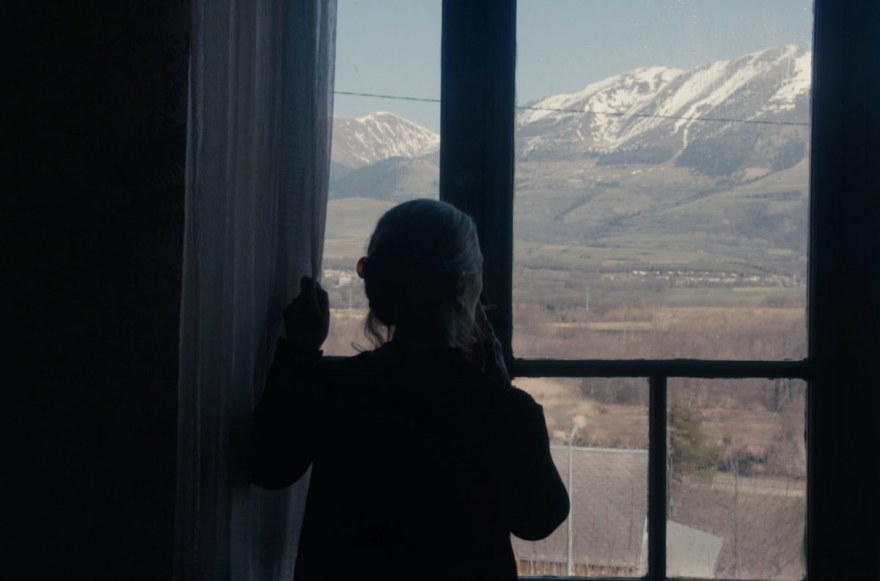Lunch with Gueule d’Isère
An interview with Esther Mysius and Camille Rouaud, directors of Gueule d’Isère
What made you want to set the film in a rural area?
The mix of mountains, forests, and mining heaps got our attention. The Plateau Matheysin has seen deep transformation throughout its history and continues to change. The coal mines closed in the early 2000’s, and this led to a landscape of workers and community. The territory of the film is, above all, the many characters that live and move through this place.
How did you work on the mood and rhythm of the film, the length of still shots and the sound conception?
We wanted the film to take its time. The time to see snowy mountains in the background. People surveying, groups hunting together. But the mood comes mainly from the sound, which is intimately connected to the landscape. This sound conception was the work of Yann Gourdon who works on how places and architecture resonate. He came during the shoot, playing his hurdy-gurdy (stringed instrument) and letting it vibrate in the actual locations. He recorded what he calls a “sound imprint” in each place. In essence, he gave a voice to this territory.
What interested you about the color red in the sequence in the mine?
From this sequence onward, the film starts to slip into more and more murky waters, that ultimately become phantasmagoria. Red is the color of passion, desire, and also danger. They go into the mine, like into the inside of a body, or of a female private part, or into the mouth of a wolf.
How did you get the idea for the sequence where you invert the colors?
The sequence was shot with a thermographic camera, whereby what is black is cold, while white shows up warmer. That way, when a cold hand touches a warm body, it leaves a mark which gradually disappears. Veins and skin blotches are visible through the skin. We see the inside of the body. And someone – Antoine with his binoculars, the hunters with their rifles, and the wolf – watches.
We got the idea to use this camera when there was a media excitement around a tiger roaming free in the greater Paris area. People took photos with their iPhones of every cat that passed by. And the city hall sent out helicopters equipped with thermographic cameras to locate the animal. It came from there, and also from the fact that today, hunters use them to find animals at night. Finally, the film Predator with Schwarzenegger and recalling the childhood memory of the vision of a monster who sees thermically. For all of these reasons, we found it interesting at that moment in the film to use it. At that point, one no longer knows who is the hunter and who is the prey, the spectator and the voyeur.
How did you create the character of Isère? DId you work on him as a “silent-type”? Why give him this first name?
Isère is the friend who stayed in the same place where he grew up. He is quiet, not because he has nothing to say, but because there is nothing to say. He watches the changes happening in his area, but he does not take a position. He is a character who is resistant, unshakeable, archaic, but also ambiguous because he can neither leave nor find his place within the community. He was named Isère, and it’s a kind of curse which connects him to the place. The wolf shows up, like a reaction to man’s influence on the territory.
What interested you in choosing the wolf? Did you choose it as a predator or a target?
The wolf is the source of all dangers as well as all hatred. It’s also a highly symbolic animal that channels fear and justifies large cathartic hunts. In the film, the wolf is a fantasized presence, almost esoteric. It fascinated us because these fantasies, as old as man, remain relevant today.
Does the short format offer any particular freedom?
This is a first film. We did not try to make it short. The format came to us, because, ultimately, it felt natural to start there. Indeed, it did offer us a great sense of freedom in making the film.
If you have been here before, tell us an anecdote about Clermont-Ferrand Film Festival. If not, what are your expectations?
Camille: I met a man at a bar two years ago. The conversation between us was strained because of a drunken man who spoke loudly. I left. The next day, I went to the photo exhibit of J-H Engström, who was a member of the festival jury that year. He was signing copies of his book of photos. He was the man from the bar! This failed encounter was frustrating, but his photographs were important references for us to start writing our film.
To see Gueule d’Isère, come to the National Competition screenings F2.








